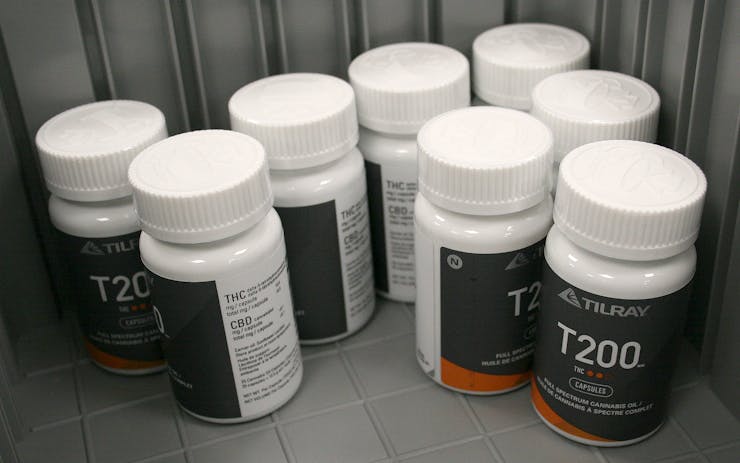This article is sponsored by Tilray, one of the largest and most sophisticated producers of medical cannabis in the world. Tilray is dedicated to providing safe, consistent, and reliable products to patients and furthering clinical and observational research examining the therapeutic potential of cannabis.
It seems like every day brings a new study about the ways medical cannabis can be used in healthcare. But how are patients already accessing medical cannabis, and in what form? And more importantly, how is it impacting their quality of life? A new study led by Philippe Lucas, Vice-President of Patient Research & Access for Tilray, and Leafly’s own Nick Jikomes, PhD, provides some of the first answers to these questions.

Tilray’s Philippe Lucas presents data from the company’s latest patient research. (Courtesy of Tilray)
The Tilray Patient Survey 2017 saw the company partner with academics and researchers from the Cleveland Clinic, McMaster University, the University of British Columbia, and the University of Victoria on the largest survey of Canadian medical cannabis patients ever conducted, tracking the responses of 2,032 patients across Canada.
Patient Preferences
Medical marijuana patients who responded to the survey were a median of 40 years old, and men outnumbered women almost two to one. About one in five respondents (22%) had private insurance, but just 3% got financial assistance to help defray the cost of their medical cannabis prescription.
Respondents were more or less evenly split between their preferences for indica (25%), sativa (22%), and hybrid strains (21%)—just ahead of users who had no preference at 17.5%. High-CBD strains were favored by just 14.5% of respondents, but CBD-heavy varieties made a strong showing among respondents who used extracts and concentrates—50% looked for a high-CBD strain in those products.
Medical Cannabis Instead Of…
Nearly 70% of users reported that they substituted medical cannabis for a previously prescribed medication. The leading substance that medical cannabis replaced? Opioids (36%), with antidepressants (21%) and other pain medications following close behind.
“In 610 mentions of opioid medication, 59% of patients stopped using these painkillers completely, and another 18% cut their consumption to a quarter or less,” said Lucas, the lead author on the study. “This suggests that cannabis may already be playing a harm-reduction role in the current opioid crisis.”

Tilray cannabis oil capsules. (Courtesy of Tilray)
These findings are consistent with US-based research by Bachhuber et al. (2014) showing a nearly 25% reduction in opioid overdose deaths in medical cannabis states compared to neighboring states that did not allow the medical use of cannabis.
It wasn’t just prescription drugs that cannabis helped patients phase out, though. Nearly a third of participants (31%) reported that using medical cannabis had helped them cut their tobacco use, and half of those respondents had quit using tobacco altogether. In addition, 44% of those surveyed reported that medical cannabis helped them consume less alcohol, and 26% said that cannabis products served as a substitute for illicit drugs.
The study also found that the two main conditions that drive patients to seek medical cannabis were chronic pain (38%) and mental health issues (40%), including anxiety and insomnia.
Although cannabis use for medical purposes is gaining acceptance as patients choose it for a variety of health challenges, it doesn’t fit the traditional “take two and call me in the morning” format of other prescriptions. With so many ways to work medical cannabis into a healthcare plan, researchers asked participants how they prefer to get their daily dose.
Flower Power
Despite the variety of delivery methods now available for medical cannabis, respondents tended to stick with a classic: flower was far and away the most popular choice for patients. Most patients (74%) used cannabis on a daily basis, and average consumption was about a gram and a half every day, translating to just over 19 ounces a year. A lot of that was consumed as joints, the most popular method of smoking medical cannabis.

A package of medicinal flower. (Courtesy of Tilray)
But while traditional flower was the most popular form of cannabis among Canadian patients, new ways of ingesting it are growing in popularity. Almost half (47%) of participants reported that their main cannabis delivery method was non-smoking. Vaporizers, including gear like e-nails and vape pens, were the favored method for 31% of respondents.
Bringing up the rear, juicing was the least popular method of consuming cannabis, with just 0.2% of survey takers calling it their primary method of use. Topicals like oils and salves just edged it out as the most popular forms of cannabis consumption among 0.3% of patients.
Cannabis may already be playing a harm-reduction role in the current opioid crisis.
Takeaways
The data patients shared with researchers demonstrates that the long-held promise medical cannabis holds for treating a broad array of conditions is starting to be realized. In particular, the initial findings of this study highlight the potential of medical cannabis to help address North America’s opioid crisis by providing a safer substitute in the treatment of chronic pain. Now, authors of the study are drafting the data into a number of academic publications that will help to better understand and contextualize the results.
“I’ve had the privilege of working with medical cannabis patients for over 20 years, and it’s an honor to be able to share their experiences through studies like the Tilray Patient Survey 2017,” Lucas said.
Disclaimer: Tilray and Leafly are both subsidiaries of Privateer Holdings, Inc.






